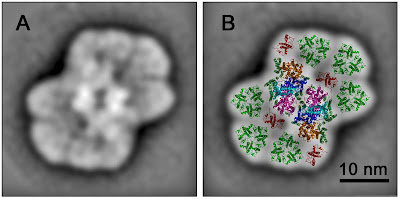7月16日
当研究室の研究成果が、研究論文として科学誌のJournal of Biological Chemistry(JBC)誌に受理されました。
論文のタイトルおよび要旨は下記の通りです。
-Title-
Revisiting the supramolecular organization of photosystem II in Chlamydomonas reinhardtii
-Authors-
Ryutaro Tokutsu, Nobuyasu Kato, Khanh Huy Bui, Takashi Ishikawa, and Jun Minagawa
-Abstract-
Photosystem II (PSII) is a multiprotein complex that splits water and initiates electron transfer in photosynthesis. The central part of PSII, the PSII core, is surrounded by light-harvesting complex II proteins (LHCIIs). In higher plants, two or three LHCII trimers are seen on each side of the PSII core whereas only one is seen in the corresponding positions in Chlamydomonas reinhardtii, probably due to the absence of CP24, a minor monomeric LHCII. Here, we re-examined the supramolecular organization of the C. reinhardtii PSII-LHCII supercomplex by determining the effect of different solubilizing detergents. When we solubilized the thylakoid membranes with n-dodecyl-β-D-maltoside (β-DM) or n-dodecyl-α-D-maltoside (α-DM) and subjected them to gel-filtration, we observed a clear difference in molecular mass. The α-DM-solubilized PSII-LHCII supercomplex bound twice more LHCII than the β-DM-solubilized supercomplex and retained higher oxygen-evolving activity. Single-particle image analysis from electron micrographs of the α-DM-solubilized and negatively stained supercomplex revealed that the PSII-LHCII supercomplex had a novel supramolecular organization, with three LHCII trimers attached to each side of the core.
☆論文内容☆
本研究では、モデル光合成藻類のクラミドモナスから、光合成反応の中心装置である光化学系タンパク質の精製法を確立しました。
特に、地球上のほぼ全ての生き物に必須である酸素を生み出す装置、光化学系II(通称:PSII)に着目しています。
先行研究で用いられている精製法を再度見直し、様々な精製条件を試行錯誤したところ、これまでの研究では見られなかった、非常に安定かつ巨大なPSIIタンパク質超複合体を見つけました。
得られたタンパク質複合体には、水を分解して酸素を生み出すPSII中心部だけでなく、光合成の最も初期の反応である『光を集める』役割を持つ、集光アンテナタンパク質(通称:LHCII)が多く含まれている事がわかりました(PSII-LHCII 超複合体)。
また、電子顕微鏡観察を用いたタンパク質単粒子解析から、このPSII-LHCII 超複合体は、陸上植物を初めとして、これまでに確認されたことのない巨大な分子構造を持つことがわかりました(上図)。
☆生物学的意義☆
昨年、岡山大学および大阪市立大学のグループにより、1.9Åという高い解像度でPSII中心部のX線結晶構造解析の結果が報告されました。
上記報告では、原核光合成生物のシアノバクテリアからPSII中心部を精製・結晶化し、詳細なタンパク質構造解析を行うことで、酸素発生部位の分子構造が明らかになりました。
X線構造解析と比較して解像度は高くありませんが、本研究の単粒子解析からは酸素発生部位であるPSII中心部と、光を集めるLHCIIが結合している様子が捉えられました(下図)。
さらに、陸上植物よりも生育が容易かつ大量に培養可能である緑藻クラミドモナスを用いることで、構造解析に必要な大量の試料を精製する事が可能になりました。
今後、本研究で得られたPSII-LHCII超複合体の結晶化・X線構造解析が進めば、陸上植物を主とした緑色(クロロフィルa/b型)の光合成生物において『LHCIIで集めた光をどのようにPSII中心部へと受け渡しているのか?』という疑問を解き明かす足がかりになることが期待されます。


0 件のコメント:
新しいコメントは書き込めません。